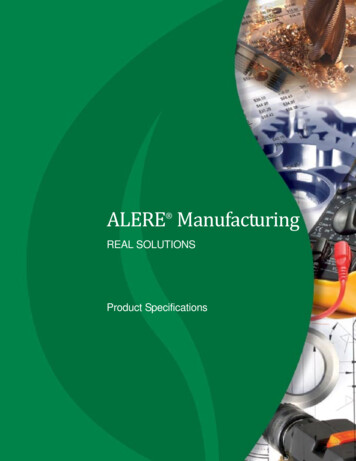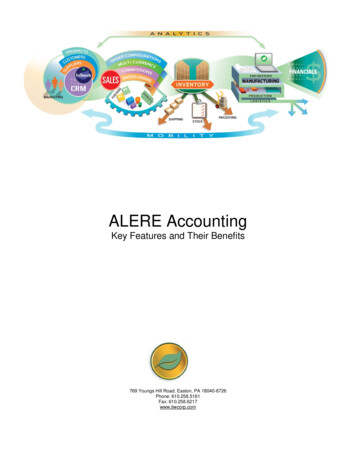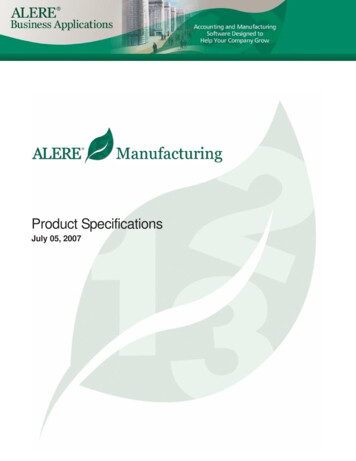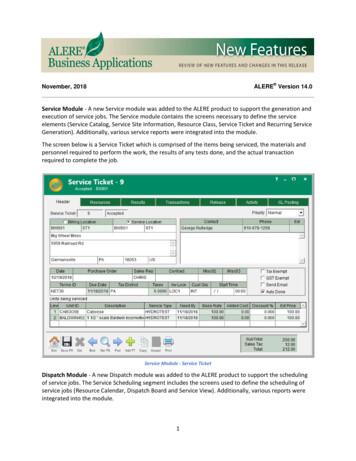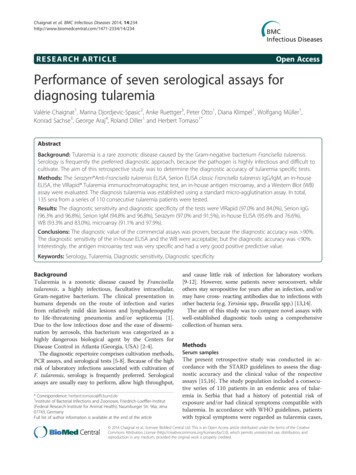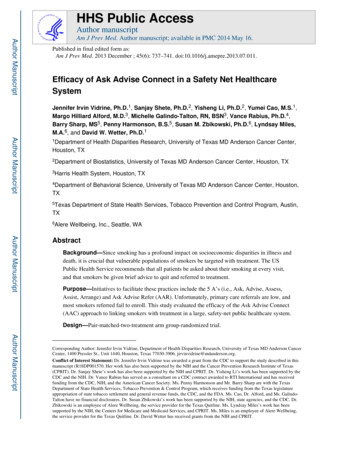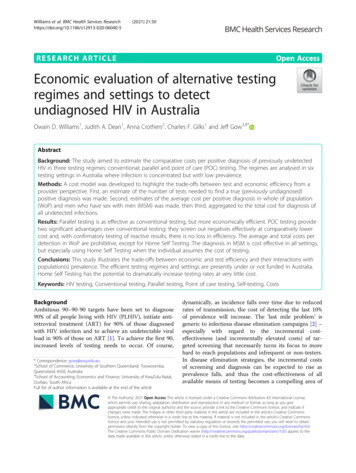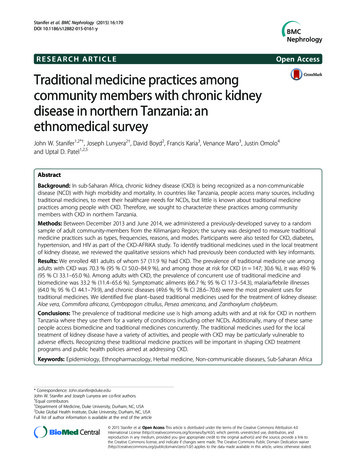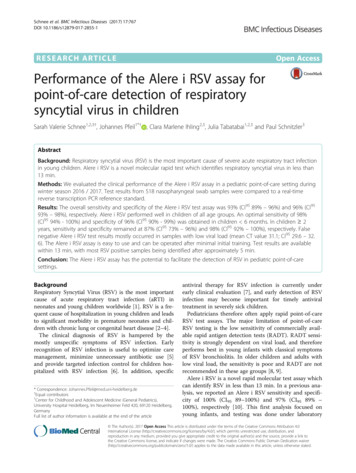
Transcription
Schnee et al. BMC Infectious Diseases (2017) 17:767DOI 10.1186/s12879-017-2855-1RESEARCH ARTICLEOpen AccessPerformance of the Alere i RSV assay forpoint-of-care detection of respiratorysyncytial virus in childrenSarah Valerie Schnee1,2,3†, Johannes Pfeil1*† , Clara Marlene Ihling2,3, Julia Tabatabai1,2,3 and Paul Schnitzler3AbstractBackground: Respiratory syncytial virus (RSV) is the most important cause of severe acute respiratory tract infectionin young children. Alere i RSV is a novel molecular rapid test which identifies respiratory syncytial virus in less than13 min.Methods: We evaluated the clinical performance of the Alere i RSV assay in a pediatric point-of-care setting duringwinter season 2016 / 2017. Test results from 518 nasopharyngeal swab samples were compared to a real-timereverse transcription PCR reference standard.Results: The overall sensitivity and specificity of the Alere i RSV test assay was 93% (CI95 89% – 96%) and 96% (CI9593% – 98%), respectively. Alere i RSV performed well in children of all age groups. An optimal sensitivity of 98%(CI95 94% - 100%) and specificity of 96% (CI95 90% - 99%) was obtained in children 6 months. In children 2years, sensitivity and specificity remained at 87% (CI95 73% – 96%) and 98% (CI95 92% – 100%), respectively. Falsenegative Alere i RSV test results mostly occurred in samples with low viral load (mean CT value 31.1; CI95 29.6 – 32.6). The Alere i RSV assay is easy to use and can be operated after minimal initial training. Test results are availablewithin 13 min, with most RSV positive samples being identified after approximately 5 min.Conclusion: The Alere i RSV assay has the potential to facilitate the detection of RSV in pediatric point-of-caresettings.BackgroundRespiratory Syncytial Virus (RSV) is the most importantcause of acute respiratory tract infection (aRTI) inneonates and young children worldwide [1]. RSV is a frequent cause of hospitalization in young children and leadsto significant morbidity in premature neonates and children with chronic lung or congenital heart disease [2–4].The clinical diagnosis of RSV is hampered by themostly unspecific symptoms of RSV infection. Earlyrecognition of RSV infection is useful to optimize caremanagement, minimize unnecessary antibiotic use [5]and provide targeted infection control for children hospitalized with RSV infection [6]. In addition, specific* Correspondence: Johannes.Pfeil@med.uni-heidelberg.de†Equal contributors1Center for Childhood and Adolescent Medicine (General Pediatrics),University Hospital Heidelberg, Im Neuenheimer Feld 420, 69120 Heidelberg,GermanyFull list of author information is available at the end of the articleantiviral therapy for RSV infection is currently underearly clinical evaluation [7], and early detection of RSVinfection may become important for timely antiviraltreatment in severely sick children.Pediatricians therefore often apply rapid point-of-careRSV test assays. The major limitation of point-of-careRSV testing is the low sensitivity of commercially available rapid antigen detection tests (RADT). RADT sensitivity is strongly dependent on viral load, and thereforeperforms best in young infants with classical symptomsof RSV bronchiolitis. In older children and adults withlow viral load, the sensitivity is poor and RADT are notrecommended in these age groups [8, 9].Alere i RSV is a novel rapid molecular test assay whichcan identify RSV in less than 13 min. In a previous analysis, we reported an Alere i RSV sensitivity and specificity of 100% (CI95 89–100%) and 97% (CI95 89% –100%), respectively [10]. This first analysis focused onyoung infants, and testing was done under laboratory The Author(s). 2017 Open Access This article is distributed under the terms of the Creative Commons Attribution 4.0International License (http://creativecommons.org/licenses/by/4.0/), which permits unrestricted use, distribution, andreproduction in any medium, provided you give appropriate credit to the original author(s) and the source, provide a link tothe Creative Commons license, and indicate if changes were made. The Creative Commons Public Domain Dedication o/1.0/) applies to the data made available in this article, unless otherwise stated.
Schnee et al. BMC Infectious Diseases (2017) 17:767conditions which may not reflect the performance inpoint-of-care settings.In the current study, we addressed these limitationsand applied the Alere i RSV test assay in a pediatricpoint-of-care setting on a larger study population acrossdifferent pediatric age groups. The objective of thisanalysis was to report an estimate of the Alere i RSV testperformance in a pediatric point-of-care setting.MethodsStudy cohort and sampling procedureBetween November 2016 and March 2017, we prospectively collected 533 nasopharyngeal swabs (NPS) in theoutpatient department of the Center of Childhood andAdolescent Medicine Heidelberg, Germany. Study inclusion criteria were I) age 18 years, II) clinical symptomsof an acute respiratory infection, and III) indication forhospitalization according to the clinical judgment of theattending physician. Patients with clinical symptoms ofan acute respiratory infection included cases of upperrespiratory tract infection (URTI), otitis media, croup,bronchiolitis, bronchitis and pneumonia.Nasopharyngeal swabs were collected by local staff in1 ml viral transport media (VTM; MSwab; Copan,Brescia, Italy). 200 μl of the VTM were directly used forpoint-of-care testing with the Alere i RSV assay. Theremaining sample was transferred to the virology diagnostic laboratory, and stored in 200 μl aliquots at 80 Cuntil further analysis.Attending pediatricians prospectively reported medical information on a standardized data sheet, including the duration of clinical symptoms, demographicand clinical data.Alere i RSV assayAlere i RSV test assays were applied in the pediatric outpatient department. The test procedure followed theAlere i RSV package insert [11]. In brief, 200 μl of therespiratory sample was added to the sample receivercontaining 2.5 ml elution buffer. Two 100 μl volumeswere added to the test base with the provided transfercartridge for isothermal amplification.Alere i RSV assays were conducted by attending physicians or nurses working in the pediatric outpatientdepartment. All operators were allowed to carry out thetest assay only after an initial hands-on-training. Testresults were printed and reported on the medical datasheet. Invalid test results were re-tested immediately.Reference standard (RT-PCR test procedures)The Alere i RSV assay was evaluated against a CEmarked real-time reverse transcriptase polymerase chainreaction assay (RT-PCR).Page 2 of 6For RT-PCR analysis, RNA was extracted from 140 μlrespiratory specimen using the QIAamp viral RNA minikit (Qiagen, Hilden, Germany) according to the manufacturer’s protocol. Amplification and detection of viralRNA was performed by FTD respiratory pathogens 21multiplex PCR (FTD 21, Fast-track diagnostics Ltd.,Sliema, Malta) on a LightCycler 480 instrument II(Roche, Mannheim, Germany). The FTD 21 assay candetect the following pathogens: influenza A, H1N1 or B,rhinovirus, respiratory syncytial virus, bocavirus, adenovirus, parainfluenza 1, 2, 3 or 4, coronavirus NL63,229E, OC43 or HKU1, parechovirus, enterovirus, humanmetapneumovirus A/B and Mycoplasma pneumoniae.FTD 21 results that did not correspond to the Alere itest assay were verified by a second RT-PCR assay. Forthis purpose, RNA was extracted from an independentsample aliquot and analyzed by altona RealStar PCR(altona RealStar RSV RT-PCR, altona Diagnostics,Hamburg, Germany). To preclude possible discrepanciesbetween the two RT-PCR methods, samples with different results in monoplex and multiplex PCR were againtested by the FTD 21 assay (Additional file 1: Figure S3).Both the FTD 21 and the altona RealStar assay wereinitially evaluated using defined RSV A and RSV B positive and negative samples from patients, from theGerman RSV reference laboratory and from the officialGerman proficiency testing panel. Results with a cyclethreshold (CT) value of 35 were considered positive.For sub-typing of RSV positive samples, Sanger sequencing targeting the second hyper-variable region of the Ggene was performed using primer pairs as previouslydescribed [12]. Resulting sequences were assembled andedited using the SEQMAN II software of the Lasergenepackage (DNAstar, Madison, WI) and allocated to subtype RSV A or RSV B using the Basic Local AlignmentSearch Tool (BLAST; http://blast.ncbi.nlm.nih.gov).Statistical analysis and data reportingStatistical analyses were conducted using Stata/IC13.0(StataCorp. LP, College Station, TX, USA). MannWhitney-U-test was applied to compare CT values insamples with true positive versus false negative Alere iRSV result. The Alere i RSV sensitivity in RSV A versusRSV B positive samples was compared using the χ2-Test.P values 0.05 were considered statistically significant.Data reporting was done according to STARD 2015recommendations [13].ResultsFrom November 2016 to March 2017, 533 NPS werecollected from 499 children presenting with symptomsof acute respiratory tract infection. Fifteen samples wereexcluded from the final analysis due to unavailability ofsample aliquots for RT-PCR testing (n 7), duplicate
Schnee et al. BMC Infectious Diseases (2017) 17:767Page 3 of 6Fig. 1 Study Flow ChartTable 1 Baseline demographic and clinical characteristics of 518study participantsN 518n% of totalmale29257%female22643%0–5 months21241%genderage6–11 months7615%12–23 months10721% 2 years12324% 3 days27653% 3 days21842%unknown245%duration of clinical symptoms on admissionadmission e grouped the admission diagnoses in cases of URTI (n 81, including URTI,otitis media and croup), LRTI (n 257, including bronchiolitis, bronchitis andpneumonia) and non-respiratory admission diagnoses (n 180). The latterincludes children admitted for non-respiratory reasons (e.g. febrile convulsion,diarrhea) with concomitant acute RTIsampling of patients during one hospital stay (n 7), ormissed re-testing of an initially invalid Alere i RSV testresult (n 1).Five hundred eighteen samples (97% of 533 collectedNPS) from 492 children were included in the finalanalysis (Fig. 1). Demographic and clinical characteristicsof the study participants are summarized in Table 1.Alere i RSV was positive in 43% (224/518) andnegative in 57% (294/518). In comparison to the RTPCR reference standard, the Alere i RSV test result wastrue positive in 213 and true negative in 278 samples,respectively. False positive test results were reported in11 patients, and 16 patients were identified with falsenegative Alere i RSV test outcome (Table 2). The overallAlere i RSV test sensitivity and specificity was 93% (CI9589% – 96%) and 96% (CI95 93% – 98%), respectively.The mean FTD 21 CT value of true positive sampleswas 17.7 (CI95 17.1–18.3; range 11.7–34.6). NPS withfalse negative Alere i RSV result had a significantlyhigher mean CT value of 31.1 (CI95 29.6–32.6; range25.4–34.5, P 0.001; Mann-Whitney-U-test).Table 2 Cross tabulation of Alere i RSV test results by theRT-PCR resultAlere i RSV positiveAlere i RSV negativetotalRT-PCR positive21316229RT-PCR negative11278289total224294518
Schnee et al. BMC Infectious Diseases (2017) 17:767Page 4 of 6Table 3 Alere i RSV test sensitivity and specificity by admission diagnosis and age groupAlere i RSV test resulttrue positivefalse negative21316total229sensitivity in% (CI95)Alere i RSV test resulttrue negativefalse positive93 (89–96)27811totalspecificityin % (CI95)28996 (93–98)admission diagnosisURTI21021100 (84–100)5736095 (86–99)LRTI159616596 (92–99)8939297 (91–99)non-respiratory33104377 (61–88)133513896 (92–99)0–5 months112211498 (94–100)9449896 (90–99)6–11 months3323594 (81–99)4014198 (87–100)age group12–23 months3474183 (68–93)6246694 (85–98) 2 years3453987 (73–96)8328598 (92–100)RSV A infection was detected in 65% (149 / 229) andRSV B in 32% (74 / 229) of RSV positive NPS. In twosamples, both RSV A and B were identified. In 4 cases,no subtype could be determined. The sensitivity of theAlere i RSV assay was 93% (CI95 87% – 96%) in RSV Aand 96% (CI95 89% – 99%) in RSV B positive samples.This difference was not statistically significant (P 0.3,χ2-Test).From the clinical perspective, CT values were higher(and hence viral load lower) in respiratory specimens ofolder children and children admitted for non-respiratoryreasons with concomitant respiratory tract infection(Additional file 1: Table S1). In consequence, the Alere iRSV sensitivity was 98% (CI95 94% - 100%) in children 6 months, 94% (CI95 81% - 99%) in children 6–11 months, 83% (CI95 68% - 93%) in children 12–23 months and 87% (CI95 73% - 96%) in children above2 years of age (Table 3). In children hospitalized forURTI or LRTI, the Alere i RSV test sensitivity was 100%(CI95 84–100%) and 96% (CI95 92–99%), respectively. Inchildren who were admitted for non-respiratory reasons,we found a sensitivity of 77% (CI95 61% – 88%) (Table 3).As illustrated in Additional file 1: Figure S2, the relativelypoor sensitivity in this group resulted from a high proportion of samples with low viral load (CT value 30), and coinfection with Influenza A, Parainfluenza, Rhinovirus orCoronavirus was detected in 5 / 10 cases.We did not undertake comprehensive analytical specificity testing but note that the 289 NPS with negativeRT-PCR result included samples tested positive for Influenza A, H1N1 or B (n 42), Rhinovirus (n 99),Bocavirus (n 23), Adenovirus (n 18), Parainfluenza 1,2, 3 or 4 (n 36), Coronavirus NL63, 229E, OC43 orHKU1 (n 41), Parechovirus (n 3), Enterovirus (n 3),Human metapneumovirus A/B (n 12) and Mycoplasmapneumoniae (n 3). In RSV positive specimens, observed coinfections included Rhinovirus (n 38), Coronavirus (n 25), Parainfluenza (n 12), Bocavirus (n 9) and Influenza (n 8). In 65 cases, neither RSV norany of the above-mentioned pathogens were detected.In our point-of-care setting, positive test results wereidentified after a mean duration of 5.1 min (CI95 4.9–5.2 min; range 4.7–10.0 min). This included both samplepre-heating (3 min) and the amplification reaction. Afterthe first testing, invalid results were reported in 6% (29/518). These NPS were directly retested, and valid (positive or negative) results were obtained in all cases.DiscussionWe found that the novel Alere i RSV assay has a sensitivity of 93% (CI95 89% – 96%) and a specificity of 96%(CI95 93% – 98%) in a pediatric point-of-care setting.The test is user-friendly and test results are obtained inless than 13 min, with most positive test results beingidentified after approximately 5 min.No direct comparison of Alere i RSV versus RADTwas done in our study. Based on published data, theexpected RADT sensitivity in young children is approximately 80% [9]. In our study setting, we previously founda RADT sensitivity of 63% (CI95 55–72%) [14] and 55%(CI95 45% – 64%) [15] over two different winter seasons.The Alere i RSV sensitivity is clearly superior to theexpected RADT performance.In children aged 24–35 months with lower viral load,the use of RADT is particularly limited with reportedsensitivity of approximately 60% [16]. In patients 2 yearsof age, we found an Alere i sensitivity and specificity of87% and 98% in comparison to our RT-PCR referencestandard, respectively. The Alere i assay is suitable forpoint-of-care detection of RSV in children across all agegroups.Other sensitive rapid nucleic acid amplification assaysare available for early detection of RSV infection. Theseassays require a testing time of at least 30 min to morethan 1 h [17, 18]. Alere i RSV test results are available
Schnee et al. BMC Infectious Diseases (2017) 17:767within 13 min, and positive test results are called outafter a mean duration of approximately 5 min.A limitation of our study is the use of VTM for Alere iRSV testing instead of directly inserting the swab to theAlere test base. Using VTM was required to establishthe RT-PCR reference standard. This procedure is inaccordance with the Alere i RSV package insert, but implies that samples are 1:5 diluted in comparison to directly inserting the swab. In our analysis, this could haveprovoked false negative results in samples with low viralload, and regular point-of-care users might prefer direct,non-diluted testing of swab specimens. Second, we compared Alere i RSV test results against a multiplex RTPCR reference standard. Only divergent results were further evaluated by monoplex RT-PCR. Multiplex RT-PCRis usually slightly less sensitive than monoplex RT-PCRin samples with low viral load. [19] In pediatric patients,viral loads are usually high and in fact, 95% of our RSVpositive samples had a CT value 30. We therefore believe that multiplex RT-PCR is a rigorous referencestandard in our study cohort, but acknowledge that applying a monoplex RT-PCR reference standard mighthave resulted in a slightly lower sensitivity of the Alere iRSV assay.In summary, we evaluated the novel Alere i RSV assayin a pediatric emergency setting against a RT-PCR reference standard. The Alere i RSV performed well in thepoint-of-care setting, and sensitive test results wereobtained across all pediatric age groups within 13 min.The assay requires a shorter test time than othercurrently available molecular test assays, and provides asignificantly higher sensitivity than RADT assays.ConclusionsThe Alere i RSV assay performs well in the pediatricpoint-of-care setting. The assay is easy to use, and thehigh sensitivity and specificity of test results help pediatricians to act appropriately both in patients with andwithout RSV infection.Additional fileAdditional file 1: Supplementary Files (DOCX 206 kb)Abbreviationsaltona RealStar PCR: altona RealStar RSV RT-PCR, altona Diagnostics, Hamburg,Germany; aRTI: acute respiratory tract infection; CT: cycle threshold; FTD21: FTD respiratory pathogens 21 multiplex PCR; LRTI: lower respiratory tractinfection; NPS: nasopharyngeal swabs; RADT: rapid antigen detection tests;RSV: Respiratory syncytial virus; RT-PCR: real-time reverse transcriptasepolymerase chain reaction assay; URTI: upper respiratory tract infection;VTM: viral transport mediaAcknowledgementsWe thank the physicians and nurses at the Center for Childhood andAdolescent Medicine for collecting respiratory samples and the techniciansin the virology diagnostic laboratory for excellent technical assistance.Page 5 of 6FundingAlere i RSV and RT-PCR tests were partly provided by Alere free of charge.Alere had no influence on the study procedure and analysis of study results.S.V.S., C.I. and J.T. are financially supported by fellowships of the GermanCenter for Infectious Diseases (DZIF). J.P. is the recipient of an HRCMM(Heidelberg Research Center for Molecular Medicine) Career DevelopmentFellowship.Availability of data and materialsAll data generated or analysed during this study are included in thispublished article and its supplementary information files.Authors’ contributionsSVS, JP and CMI conducted study experiments. SVS and JP wrote themanuscript. All authors (SVS, JP, CMI, JT and PS) contributed to theinterpretation of study results and approved the final version of thismanuscript.Ethics approval and consent to participateThis study was approved by the Ethical Research Board of the UniversityHospital Heidelberg, Germany (S-547/2015). All samples and medicalinformation included in this study were obtained during routine medicalcare. Written consent for the analysis and publication of the data included inthis study was obtained from all parents or guardians.Consent for publicationNot applicableCompeting interestsAlere i RSV and RT-PCR test materials were partly provided by Alere free ofcharge.Publisher’s NoteSpringer Nature remains neutral with regard to jurisdictional claims inpublished maps and institutional affiliations.Author details1Center for Childhood and Adolescent Medicine (General Pediatrics),University Hospital Heidelberg, Im Neuenheimer Feld 420, 69120 Heidelberg,Germany. 2German Center for Infection Research (DZIF), Heidelberg partnersite, Heidelberg, Germany. 3Center for Infectious Diseases, Virology, UniversityHospital Heidelberg, Heidelberg, Germany.Received: 23 August 2017 Accepted: 26 November 2017References1. Nair H, Nokes DJ, Gessner BD, Dherani M, Madhi SA, Singleton RJ, O'BrienKL, Roca A, Wright PF, Bruce N, et al. Global burden of acute lowerrespiratory infections due to respiratory syncytial virus in young children: asystematic review and meta-analysis. Lancet. 2010;375:1545–55.2. Bashir U, Nisar N, Arshad Y, Alam MM, Ashraf A, Sadia H, Kazi BM, Zaidi SS.Respiratory syncytial virus and influenza are the key viral pathogens inchildren 2 years hospitalized with bronchiolitis and pneumonia inIslamabad Pakistan. Arch Virol. 2017;162:763–73.3. Iwane MK, Edwards KM, Szilagyi PG, Walker FJ, Griffin MR, Weinberg GA,Coulen C, Poehling KA, Shone LP, Balter S, et al. Population-basedsurveillance for hospitalizations associated with respiratory syncytial virus,influenza virus, and parainfluenza viruses among young children. Pediatrics.2004;113:1758–64.4. Schanzer DL, Langley JM, Tam TW. Hospitalization attributable to influenzaand other viral respiratory illnesses in Canadian children. Pediatr Infect Dis J.2006;25:795–800.5. Adcock PM, Stout GG, Hauck MA, Marshall GS. Effect of rapid viral diagnosison the management of children hospitalized with lower respiratory tractinfection. Pediatr Infect Dis J. 1997;16:842–6.6. Madge P, Paton JY, McColl JH, Mackie PL. Prospective controlled study offour infection-control procedures to prevent nosocomial infection withrespiratory syncytial virus. Lancet. 1992;340:1079–83.7. Jorquera PA, Tripp RA. Respiratory syncytial virus: prospects for new andemerging therapeutics. Expert review of respiratory medicine. 2017;
Schnee et al. BMC Infectious Diseases (2017) 17:7678.9.10.11.12.13.14.15.16.17.18.19.Page 6 of 6Casiano-Colon AE, Hulbert BB, Mayer TK, Walsh EE, Falsey AR. Lack ofsensitivity of rapid antigen tests for the diagnosis of respiratory syncytialvirus infection in adults. Journal of clinical virology : the official publicationof the Pan American Society for Clinical Virology. 2003;28:169–74.Chartrand C, Tremblay N, Renaud C, Papenburg J. Diagnostic accuracy ofrapid antigen detection tests for respiratory Syncytial virus infection:systematic review and meta-analysis. J Clin Microbiol. 2015;53:3738–49.Peters RM, Schnee SV, Tabatabai J, Schnitzler P, Pfeil J. Evaluation of Alere iRSV for rapid detection of respiratory syncytial virus in children hospitalizedwith acute respiratory tract infection. J Clin Microbiol. 2017;Alere i RSV package insert. Available at e-i-rsv.html].Peret TC, Hall CB, Schnabel KC, Golub JA, Anderson LJ. Circulation patternsof genetically distinct group a and B strains of human respiratory syncytialvirus in a community. The Journal of general virology. 1998;79(Pt 9):2221–9.Bossuyt PM, Reitsma JB, Bruns DE, Gatsonis CA, Glasziou PP, Irwig L, LijmerJG, Moher D, Rennie D, de Vet HC, et al. STARD 2015: an updated list ofessential items for reporting diagnostic accuracy studies. BMJ. 2015;351:h5527.Pfeil J, Tabatabai J, Sander A, Ries M, Grulich-Henn J, Schnitzler P. Screeningfor respiratory syncytial virus and isolation strategies in children hospitalizedwith acute respiratory tract infection. Medicine. 2014;93:e144.Hoos J, Peters RM, Tabatabai J, Grulich-Henn J, Schnitzler P, Pfeil J. Reversetranscription loop-mediated isothermal amplification for rapid detection ofrespiratory syncytial virus directly from nasopharyngeal swabs. J VirolMethods. 2017;242:53–7.Papenburg J, Buckeridge DL, De Serres G, Boivin G. Host and viral factorsaffecting clinical performance of a rapid diagnostic test for respiratorySyncytial virus in hospitalized children. J Pediatr. 2013;Wahrenbrock MG, Matushek S, Boonlayangoor S, Tesic V, Beavis KG,Charnot-Katsikas A. Comparison of Cepheid Xpert flu/RSV XC and BioFireFilmArray for detection of influenza a, influenza B, and respiratory Syncytialvirus. J Clin Microbiol. 2016;54:1902–3.Salez N, Nougairede A, Ninove L, Zandotti C, de Lamballerie X, Charrel RN.Prospective and retrospective evaluation of the Cepheid Xpert(R) flu/RSV XCassay for rapid detection of influenza a, influenza B, and respiratory syncytialvirus. Diagn Microbiol Infect Dis. 2015;81:256–8.Sakthivel SK, Whitaker B, Lu X, Oliveira DB, Stockman LJ, Kamili S, ObersteMS, Erdman DD. Comparison of fast-track diagnostics respiratory pathogensmultiplex real-time RT-PCR assay with in-house singleplex assays forcomprehensive detection of human respiratory viruses. J Virol Methods.2012;185:259–66.Submit your next manuscript to BioMed Centraland we will help you at every step: We accept pre-submission inquiries Our selector tool helps you to find the most relevant journal We provide round the clock customer support Convenient online submission Thorough peer review Inclusion in PubMed and all major indexing services Maximum visibility for your researchSubmit your manuscript atwww.biomedcentral.com/submit
Alere i RSV assay Alere i RSV test assays were applied in the pediatric out-patient department. The test procedure followed the Alere i RSV package insert [11]. In brief, 200 μl of the respiratory sample was added to the sample receiver containing 2.5 ml elution buffer. Two 100 μl volumes were added to the test base with the provided transfer


